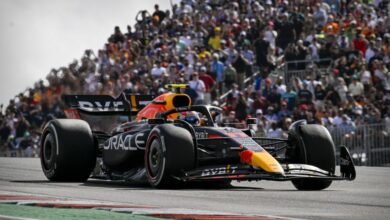FIA Addresses Inspection Feasibility After Hamilton and Leclerc’s Disqualification at Austin GP
In the wake of the Austin GP controversy, where Lewis Hamilton and Charles Leclerc were disqualified for excessive skid block wear, the FIA declared the impracticality of scrutinizing every car’s detail. Amidst debates over fairness and scrutiny thoroughness, the FIA defended its stance on random checks and the challenges of exhaustive inspections.
Key Takeaways:
- FIA’s Practical Limitations: Following the disqualifications of Hamilton and Leclerc at the Austin GP, the FIA responded to criticisms about its scrutineering process, emphasizing the impracticality of inspecting every component on every car due to time constraints and logistical challenges.
- Random Checks Justified: The FIA maintains that its protocol of randomly checking parts of cars post-race is effective. This approach, which leaves teams uncertain about what will be inspected, is believed to discourage rule violations.
- In-Depth Single Car Checks: Despite the limitations, the FIA also conducts comprehensive checks on one car per event, involving detailed component disassembly and comparison against CAD files and team data, though these are not routine due to their invasive nature.

The recent controversy surrounding Lewis Hamilton and Charles Leclerc’s disqualification from the Austin Grand Prix has sparked a significant debate in the Formula 1 world. The FIA faced scrutiny after it was revealed that only four cars were inspected post-race, with half of them failing the checks for excessive plank wear.
In a statement, the FIA explained the challenges of scrutineering every car. They pointed out the time limitations, especially during back-to-back race weekends, and the logistical difficulties of comprehensive checks on every single vehicle. This explanation came in light of Martin Brundle’s criticism in his Sky F1 column, where he questioned why not all cars were checked considering the 50% failure rate among those inspected.
The FIA’s process involves random checks of various car parts to maintain compliance with technical regulations. This randomness is a strategic move to keep teams on their toes, as they can’t predict which parts might be scrutinized. The FIA stated, “This means that, from their perspective, any part of the car could be checked at any time, and the consequences for non-compliance with the technical regulations can be severe.”
Apart from random checks, the FIA also conducts more extensive tests on a single car at each event. These ‘deep dives’ are more invasive and involve disassembling significant components, comparing physical parts with CAD files, and verifying team data. This thorough process is not routine due to the time-intensive nature of the procedure.
In conclusion, while the FIA recognizes the importance of fair and thorough scrutineering, it also emphasizes the practical limits of what can be achieved within the available timeframe and logistical constraints. The balance between random checks and deep dives appears to be their solution to maintaining rule compliance while managing the realities of a tightly scheduled race calendar.


